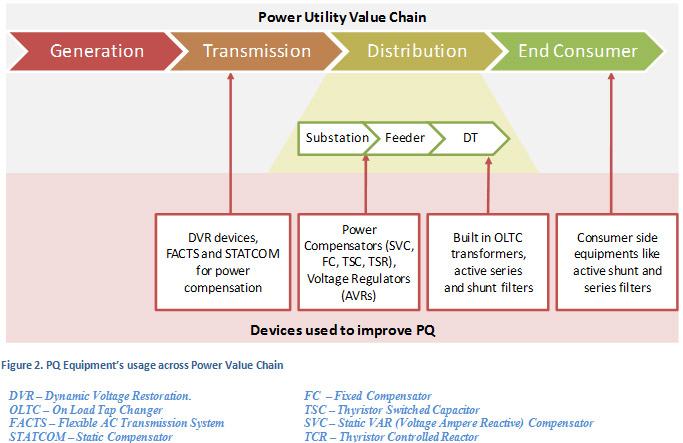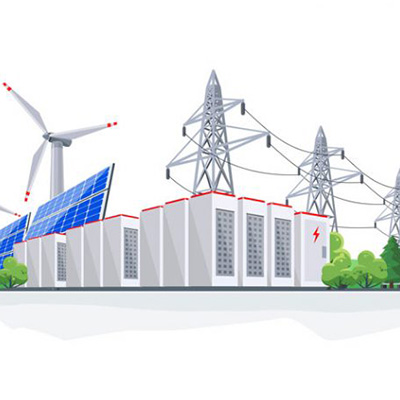Published On: Jul 06, 2014
Power Quality refers to the stability and consistency of the electricity supply. As we connect more and more electronic devices to our power systems, the ‘quality’ of power supply becomes increasingly important. Stable voltages and undistorted waveforms are two characteristics which are very desirable in today’s power systems.
Various PQ issues like voltage unbalance, poor voltage profile or sag, excessive currents on neutral wires, equipment damage or component like relay /protection failure due to poor PQ environment, etc. also have operational impacts on electricity network (Refer our blog T&D Network Planning – Do Utilities Consider Power Quality? , that relates technical losses with poor PQ ecosystem).
Given the breadth and depth of the conditions that cause power quality issues, the importance of understanding PQ problems and how to mitigate them will continue to gain widespread relevance for facility operators, electrical contractors and utility personnel. The solution to this problem is nothing different than what we are already terming as priority for our Power Distribution system – i.e. upgrading India’s aging electricity distribution grid. There is an urgent need of modernizing our power grids to solve few of the biggest problems including high technical losses, poor reliability and increasing O&M costs.
T&D losses are caused in the process of transmission of electricity from generation to end consumers. A significant part of such losses are technical in nature caused due to improper load management, inadequate investment on system, haphazard growth of power systems (with the short term objective), inadequate reactive compensation, substandard procurement of equipments in some cases and others. About 75% of the total technical losses (and almost entire commercial losses) occur at the distribution stage across the power utility value chain.
At 23% (as of 2012), technical losses in India are among the highest in the world. Some of the developed countries like Europe, USA, Germany, etc. have controlled it in the range of 5-12%.The main reason for high technical losses in India is insufficient investment made in the distribution sector primarily. While the investment in generation and to certain extent in transmission has been steady, the investment in distribution has not kept up with it. Unless there is strengthening of the existing grids, the load, dominantly nonlinear in nature, on the electricity systems will continue to increase resulting in increased losses. These high losses are impacting the financial health of state distribution utilities. State utilities reportedly are facing a huge burden of nearly Rs. 2.4 Lakh crores (~around 1.8 Lakh Crores due to technical losses alone)
Thus, it is crucial for Indian Power Distribution Utilities to understand and consider PQ in line with technical loss reduction. This will require considerable investments in infrastructure, along with using PQ equipment. The equipment used in the distribution systems are long overdue for maintenance/up gradation and are operating inefficiently. Hence, utilities must consider PQ improvement as one of the key business operations, which will be beneficial in reducing the high technical losses prevalent in the system.
THE BUSINESS CASE FOR PQ INVESTMENTS BY UTILITIES
Power Quality improvement requires utilities to have a relook at their strategies for making appropriate investments in the network. The key question for most decision makers is thus, Whether a business case for PQ investment by Indian Power Distribution Utilities exists? Another question in deregulated energy sector of future is “Can PQ be a market differentiator for utility business?”
To understand more on the topic, Asia Power Quality Initiative (APQI) recently hosted a webinar on the same engaging utility professionals and industry experts. The discussion attempted to establish the potential business case for Indian utilities which called for upgrades to distribution Networks leading to reliable power for end consumers. (View the full Webinar video and speaker’s presentation) . Key discussions points from this are captured further.
The key elements of major PQ issues are reactive power, load imbalance and harmonics in the network. These lead to high running costs, failures of equipment, suboptimal capacity utilization and subsequently cause customer dissatisfaction. PQ issues also lead to excessive heating of electrical equipment and assets, equipment malfunctioning and their failure. Strained distribution systems further aggravate economic problems for the utilities.
Thus, there is a need to improve PQ in Distribution network to increase load capacity, extend electrical equipment life and reduce technical loss.
Examples of impact due to poor power quality:
|
|
Losses/year |
CO2 emissions/year |
|
Small/medium transformers |
3000 € |
30 T |
|
Large transformers |
10000 € |
100 T |
|
LV Cables (per 100 m) |
1500 € |
15 T |
|
Motors |
10 % additional losses |
10 % additional emissions |
Shows losses/year and CO2 emissions per year in electrical assets due to PQ issues
It can be seen from above table that poor PQ results not only in financial losses, but has other serious environmental impacts as well.
Some of the ways suggested for improving PQ include the following:
- Automatic Voltage Control Devices: which can improve voltage profile at customer end.
- Active Power Factor Correction (APFC): which can be used to improve PQ. It has the advantages of reducing transmission losses, avoiding transformer overloading, avoiding over compensation, reducing power outages
- Source and Load balancer: gives improved voltage stability, reduced losses in motors connected as load and helps maintain balanced input
- Peak Power Control: ;helps in reducing peak power demand and intelligent load control management
- Concept of Digital substation: brings with it multiple benefits of cost reduction, improved safety, standardization and interoperability, increased reliability and availability, asset optimization (intelligent monitoring of equipment), investment optimization and improved communication capability inside and between the substations
- Efficient reactive power management: in order to avoid issues like poor power factor and system losses. Reactive power compensation can be achieved through means of Fixed Capacitor Bank and Switched Capacitor Banks
CASE STUDY ON USING POWER QUALITY SYSTEMS FOR ELECTRIC UTILITIES
Problem Statement: Electric utility was not having actionable data on PQ Issues being faced. Corrective actions were difficult to make because of which they were incurring system reliability issues and also required to annually pay huge claims to customers due to these PQ issues.
Solution: The utility installed and configured PQ software and measurement systems at substations, thereby allowing measurement of PQ on distribution feeders. The system was integrated with communication infrastructure to facilitate communication and to monitor PQ parameters on a real time basis.
Benefits of the system
- The system helped the utility in identifying early warning of PQ issues like voltage sags & swells, interruptions, harmonics, etc., accurately measuring PQ parameters for actionable data.
- The utility was able to benchmark its performance against International PQ Standards
- Improved understanding of PQ information throughout the distribution network
- Improved reliability of electricity supply and information sharing with customers concerning quality of supply and others
(Read on more: How Power Quality Systems are saving Electric Utilities Money. The document showcases three examples of Electric Utilities. We have briefly explained the scenario of first case study of Jamaica Electric Utility)
USE OF PQ EQUIPMENTS BY UTILITIES ACROSS POWER VALUE CHAIN
CHALLENGES OF DRIVING PQ ISSUES INDEPENDENTLY AND NEED OF STAKEHOLDER ENGAGEMENT
One of the biggest challenges in PQ is determining the source of poor power quality. It can prove to be a complex and tedious task. Ensuring high Power Quality involves a large number of stakeholders, from network providers, original electrical equipment manufacturers and service providers, regulators, end users, etc. The problems that are faced by the end consumers may vary in nature from the problems faced by the network providers and similarly for the other stakeholders. In addition, many of the sources of power quality disturbances are interactive, making it difficult to accurately trace them and diagnose the root cause of the problem. Various PQ issues are categorized according to the different stakeholders.
At the consumer level: consumers suffer due to under-voltage, light-flickering, etc. resulting in equipment damage or data loss followed by business down time. Large industries (for example the semiconductor industry, paper plants, glass and steel industries, etc.) suffer significant financial losses when voltage dips occur at their sites.
Whereas, at the network operator level: the problems are of a different nature. Large PQ emissions from the customers’ sides make it difficult for the network operator to maintain a high voltage quality at a customer’s point of connection (POC). In extreme cases, it can lead to high thermal stresses and eventual early ageing of the network devices.
In the above situation, it becomes blame game scenario by stakeholders (i.e. utilities, consumers, OEMs and service provider) amongst each other. Hence, to resolve power quality issues properly, it is important that the stakeholders not only have a common understanding of those issues, but also work in collaborative and cooperative ways to find solutions.
CONCLUSION
The cost of poor PQ is high and rising. The business risks posed due to PQ issues are causing significant technical and financial losses for all stakeholders involved. In order to curtail such losses, the equipment manufacturers and service providers should be able to provide devices that fulfill immunity requirements as per International Electricity Code (IEC) standards.
At a regulatory level, the equipment performance standards should be integrated with the voltage quality of the network. Such a coordinated approach in meeting standards would be useful for all involved stakeholders in the system. At the present level of evolution it is essential for deeper regulatory oversight on PQ monitoring at DT level (an ideal profit center for utility) and transparent disclosure of such information.
Thus, the need of the hour is to provide credible and systematic solutions rather than fly by night, black box recommendations to utilities investing in distribution network improvements.
Further, for PQ market development and transformation, OEM and service providing stakeholders shall recognize the importance of working with an independent and neutral platform like Asia Power Quality Initiative (APQI), rather than promoting brand through independent market effort. Similarly utilities or regulators may find such objective platform an ideal tool to carry out effective consumer advocacy and education for creating a trustworthy win-win situation. This combined effort will result in improvement of Power Quality in our Distribution Networks at a greater pace.
REFERENCES
- The Economic Impact of Effective Power Quality Monitoring.
- Ross Ignall, “Power Quality Surges in Importance – PQ is a major factor as Facilities Go Green”.
- Power Quality Problems and Solutions.
- Roger Lawrence, P.E., CEM, FIEEE, RGL Solutions, “Uncovering Power Quality Culprits”.
- Common Causes of Power Quality Problems.
- Jerry Olechiw, Vice President of Sales – Dranetz, General Manager – Electrotek Concepts, Case Study: How Power Quality Systems are Saving electrical utilities money”.
- Power Quality and Drives LLC.
- Marty Martin, P.E., Two Modern Power Quality Issues – Harmonics and Grounding.








